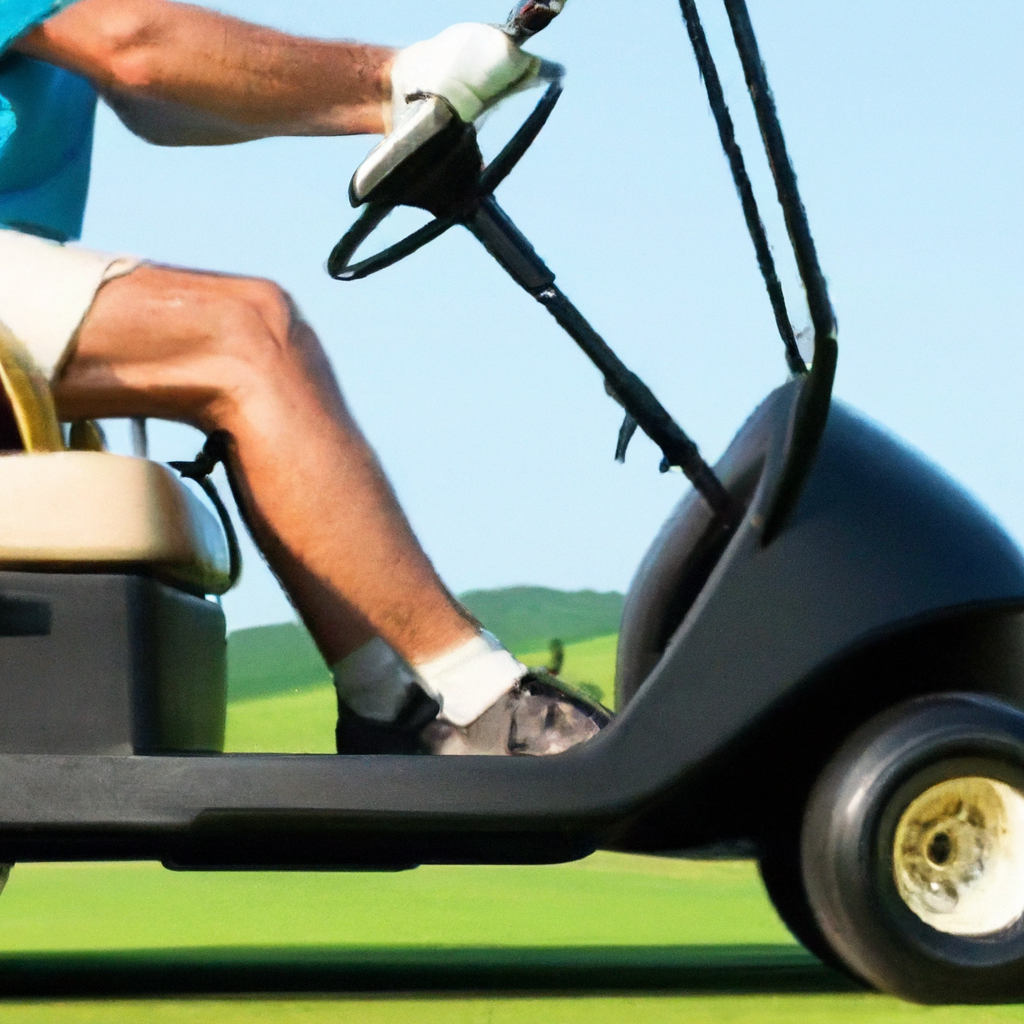Imagine cruising along a beautiful golf course, feeling the cool breeze caress your face as you effortlessly navigate the terrain in a golf cart. It’s an enjoyable experience, but safety should always be a top priority. In this article, we will walk you through the essential steps and precautions to drive a golf cart safely. Whether you’re a seasoned golfer or a novice, these tips will help ensure that your golf cart adventures are not only fun but also accident-free. So buckle up, put on your friendly smile, and let’s hit the road to a safe and enjoyable ride!

Preparation
Driving a golf cart can be a fun and convenient way to navigate around a golf course or resort. But before you get behind the wheel, it’s important to make sure you’re prepared. Follow these steps to ensure a safe and enjoyable ride.
Check the weather conditions
Before heading out, take a moment to check the weather conditions. If there’s heavy rain, thunderstorms, strong winds, or any other extreme weather, it’s best to postpone your golf cart adventure. Driving a golf cart in inclement weather can be dangerous and increase the risk of accidents. So, always prioritize safety and wait for clearer conditions.
Familiarize yourself with the golf cart
Each golf cart may have slight differences in functions and controls, so it’s important to familiarize yourself with the specific model you’ll be driving. Take a few minutes to read the user manual or ask someone experienced to show you the ropes. Learn where the ignition is, how to engage the parking brake, how to operate the lights, and any other unique features of the cart. This knowledge will make you feel more confident and comfortable while driving.
Wear appropriate clothing and footwear
To ensure your safety and comfort while driving a golf cart, it’s important to wear appropriate clothing and footwear. Choose comfortable attire that won’t restrict your movement, such as shorts or pants and a t-shirt. Avoid loose clothing or items that could get caught on the controls. As for footwear, opt for closed-toe shoes with a good grip. Sandals or flip-flops are not suitable for driving a golf cart as they may impede your ability to control the vehicle properly.
Safety Equipment
Safely operating a golf cart means taking necessary precautions and having the right safety equipment on hand. Here are some essential items to consider:
Wear a seatbelt
While golf carts may not be as fast as regular vehicles, it’s still crucial to wear a seatbelt while driving one. Seatbelts can prevent serious injuries in the event of a collision or sudden stop. Ensure that everyone in the cart wears their seatbelts properly, keeping them securely fastened throughout the ride.
Use mirrors
Most golf carts come equipped with side mirrors that provide a clear view of what’s behind you. Utilize these mirrors to check for any approaching vehicles or pedestrians before changing lanes or making turns. Regularly adjust them to ensure optimal visibility.
Ensure the cart has functioning headlights and taillights
Driving a golf cart at night or in low-light conditions necessitates proper lighting. Before setting off, make sure the cart’s headlights and taillights are functioning correctly. This will enhance your visibility to others and help prevent accidents. If you notice any faulty lights, have them repaired before using the cart.
Install a rearview mirror
In addition to side mirrors, a rearview mirror can significantly enhance your situational awareness while driving a golf cart. It allows you to keep an eye on what’s happening behind you without having to turn your head constantly. Consider installing a rearview mirror if your cart doesn’t already have one.
Keep a first aid kit on board
Accidents can happen anywhere, and it’s always better to be prepared. Keep a well-stocked first aid kit on board your golf cart in case of any minor injuries or medical emergencies. Include essentials such as band-aids, sterile dressings, antiseptic wipes, and any required medications. Familiarize yourself with the contents of the kit and know how to use them properly.

Starting and Stopping
Starting and stopping a golf cart may seem straightforward, but it’s essential to follow the correct procedure to ensure a safe ride. Here’s how:
Engage the parking brake
Before you do anything else, engage the parking brake. This prevents the cart from rolling forward or backward when you start the engine or come to a stop. The parking brake will typically be a lever or pedal located somewhere near the driver’s seat. Pull or press it firmly to engage the brake.
Insert the key and turn on the ignition
Locate the ignition switch, usually found on the dashboard or steering column. Insert the key, turn it clockwise, and hold it in the “on” position until the engine starts. Once the engine is running smoothly, release the key.
Release the parking brake when ready to move
With the engine running and the cart in a stationary position, it’s time to release the parking brake. Ensure that the area around the cart is clear before doing so. If you’re on an incline, release the brake gradually to avoid rolling backward or forward too quickly.
Gradually press the acceleration pedal to start
Once the parking brake is released, it’s time to start moving. Place your foot on the acceleration pedal, which is usually located on the right side of the driver’s area, similar to a car’s gas pedal. Press it gently and gradually to accelerate the cart to your desired speed.
Use the brake pedal to bring the cart to a complete stop
To stop the golf cart, use the brake pedal, typically found on the left side of the accelerator. Apply firm and steady pressure to slow down the cart and come to a complete stop. Avoid abruptly slamming on the brakes, as this can cause the cart to skid or passengers to be jolted.
Park in designated areas
When you reach your destination, park the golf cart in designated areas. Look for signs indicating where golf carts should be parked, or follow instructions given by the golf course staff. Parking in the wrong areas can cause inconvenience to others and may even result in your cart being towed or fined.
Steering and Turning
Proper steering and turning techniques are essential for maintaining control and maneuvering safely in a golf cart. Keep these tips in mind when operating the steering wheel:
Hold the steering wheel with both hands
Maintain a firm grip on the steering wheel at all times, using both hands. This allows for better control of the cart’s direction and the ability to react quickly if necessary. Avoid driving with just one hand or placing your hands on the top of the steering wheel, as it may negatively impact your control.
Use smooth and gentle movements
When steering a golf cart, opt for smooth and gentle movements rather than jerky motions. Sudden or aggressive turns can destabilize the cart and increase the risk of tipping over. Gradually and steadily rotate the steering wheel to guide the cart around corners and obstacles. Smooth movements also make the ride more comfortable for you and your passengers.
Avoid sharp turns at high speeds
While golf carts are designed to be maneuverable, it’s important to avoid sharp turns, especially when traveling at high speeds. Sharp turns can cause the cart to tip over, potentially causing injuries. Slow down before making a turn and maintain a moderate speed throughout the maneuver. This ensures stability and reduces the risk of accidents.
Steer a wide path around obstacles
When encountering obstacles such as trees, lamp posts, or other carts, steer a wide path around them. This provides ample space and reduces the likelihood of collisions. Assess the size and position of the obstacle early and adjust your path accordingly. Remember to check your mirrors to ensure there’s no cart or pedestrian approaching from behind before changing lanes or making any turns.
Use turn signals when necessary
Just like when driving a car, it’s courteous and helpful to use turn signals when making turns in a golf cart. Indicate your intentions to fellow golfers, pedestrians, or other drivers by using the appropriate turn signal. Most golf carts have turn signal levers located on the steering column. Activate the signals in advance of your turn to provide ample warning to others and avoid surprises or confusion.
Speed Control
Maintaining an appropriate speed and adjusting it to match the driving conditions can significantly enhance your safety while driving a golf cart. Here’s what you need to know about speed control:
Stay within the designated speed limit
Most golf courses and resorts have designated speed limits for golf carts. It’s important to adhere to these limits to ensure the safety of yourself, your passengers, and others sharing the environment. Driving at excessive speeds can compromise your ability to react to unexpected situations and increase the severity of any potential accidents. Always respect the speed limits and drive at a safe, controlled pace.
Slow down or stop near pedestrians or other carts
When you encounter pedestrians, other golfers, or carts on the course, it’s necessary to slow down or come to a complete stop. Yield to pedestrians and allow them the right of way. Be patient and alert, especially in congested areas or intersections. Keep a safe distance from others to prevent collisions, and only proceed when it’s safe to do so.
Adjust the speed according to terrain conditions
Different terrains can have varying levels of traction and stability. Adjust your speed accordingly to maintain control of the golf cart. Slow down when traversing uneven or bumpy areas, as well as on loose surfaces like gravel or sand. Higher speeds in these conditions can cause the cart to skid or lose traction, leading to accidents or loss of control.
Avoid sudden acceleration or deceleration
Smooth acceleration and deceleration are key to maintaining stability and passenger comfort. Avoid sudden bursts of speed or abrupt stops, as these can startle or cause discomfort to yourself and your passengers. Gradually increase or decrease your speed to maintain a steady and controlled ride. This also minimizes wear and tear on the cart’s components.
Keeping these tips in mind will help you become a considerate and safe golf cart driver. Whether you’re cruising around a golf course or resort, remember to prioritize the well-being of yourself, your passengers, and those around you. Safe driving is responsible driving, so always obey the rules, use common sense, and enjoy your golf cart experience to the fullest.
Passenger Safety
Driving a golf cart often involves transporting passengers, whether they are fellow golfers or simply friends and family enjoying a leisurely ride. Ensuring their safety is just as important as your own. Follow these guidelines to guarantee a secure and enjoyable experience for everyone on board.
Do not exceed the cart’s seating capacity
Golf carts have a specified seating capacity, usually indicated by the number of seats provided. It’s crucial not to exceed this limit, as the cart’s design and safety features are engineered to accommodate a certain number of passengers. Overloading the cart can lead to instability, reduced maneuverability, and an increased risk of accidents. Respect the seating capacity and never compromise safety for the sake of extra passengers.
Ensure all passengers are seated properly
Before starting the cart, ensure that all passengers are seated properly and securely. Encourage them to sit in designated seats and fasten their seatbelts. Loose or improperly seated passengers can be a hazard if sudden stops or turns occur. Remind everyone to keep their feet, hands, and any loose objects inside the cart at all times. Instruct children on the importance of remaining seated and not engaging in any disruptive behavior.
Keep all body parts inside the cart
To avoid accidents and injuries, all passengers should keep their body parts, especially hands and feet, inside the cart while it’s in motion. Hanging arms or legs outside the cart can lead to collisions with objects or limbs getting caught in moving parts. Encourage everyone to stay within the confines of the cart and avoid unnecessary risks. Maintaining a safe and secure environment is key to a pleasant and incident-free ride.
Maintaining Distance
Maintaining a safe distance from other carts, golfers, and objects is crucial to prevent accidents and ensure smooth navigation on the golf course or resort. Here are some guidelines for maintaining distance:
Maintain a safe distance from other carts
When driving on the course, keep a safe distance between your golf cart and other carts nearby. This distance allows for enough reaction time and prevents rear-end collisions. Maintain at least a 15-foot distance between your cart and the cart in front of you. This applies even when stopping or in congested areas. Remember, maintaining a safe distance is not only for your safety but also for the safety of others.
Keep a safe distance from golfers on the course
Golfers may be focused on their game and unaware of approaching golf carts. Always give golfers plenty of space and maintain a respectful distance. If a golfer is about to swing or is lining up their shot, come to a stop and wait until they have safely completed their stroke. Be aware of your surroundings and watch out for golfers in your vicinity. Your patience and awareness will be greatly appreciated by those enjoying their game.
Avoid tailgating
Tailgating, or driving too closely behind another vehicle, is unsafe and disrespectful. The driver in front may need to brake suddenly, and if you’re tailgating, you may not have enough time to react and avoid a collision. Maintain a reasonable distance behind other carts or vehicles to allow for safe braking and maneuverability. Tailgating can cause unnecessary stress and increase the risk of accidents, so give other drivers the space they need.
Maintaining distance is one of the foundationa
